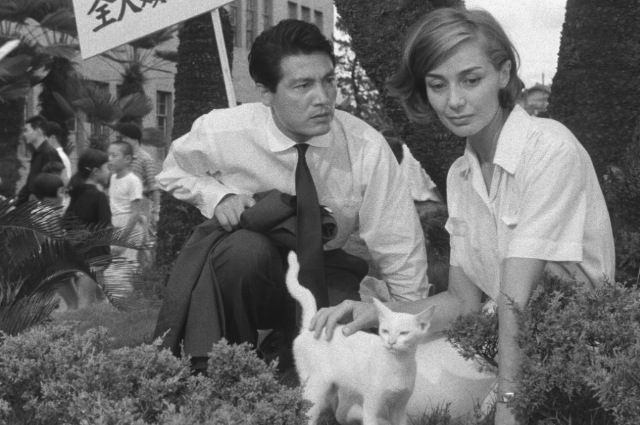"Now I am become death, the destroyer of worlds..."
The movie starts in a close-up shot of a man and a woman embracing each other, when suddenly ashes start descending and settle on them. This scene constantly creeps in between the shots of the disabled and mutilated Hiroshima victims. "The fact that they were thinking about it is worse, and that they did it is the worst. A French actress who came to Hiroshima to shoot an antiwar film narrates to a Japanese architect she met the other day how she went to the museum four times and saw the aftermath of the historic nuclear bombing. "History" is often not accurate, as it is forever engraved in the perception of a single person, often trying to be in people's good books, and we never get to know what happened through the eyes of society. Hence, the architect negates her claim of knowing about Hiroshima, which can be gained only through personally experiencing the circumstances. He lost his family in Hiroshima when he went off to fight for his motherland.
Memories..memories..memories.
"Nothing is ever really lost as long as we remember it."
The use of brief flashbacks suggests flashes of memory are used to convey the past trauma of the actress. The memories come intruding during certain
instances just like in our real lives, when we are hit with sudden surges of nostalgia at unexpected times. The Japanese man's twitching hands, where her eyes land after they share a passionate night, remind her of her late German lover lying dead on the battlefield with those shaking hands. The architect falls in love with her and is desperate to see her soon, but he doesn't get a clear reply. She confides in him and talks about the abuse and torture she faced at the hands of her French parents after her German lover died. This introduces us to another major war or timeline in history(the battle between France and Germany). Her heart was broken, and her love unfulfilled, just because she fell in love with an enemy countryman. The long shots of the movie showing the lovers embracing each other depict that they have always been watched and never had the liberty to live their lives. Such small details in this film show how selfish acts of people acting on their certain regressive beliefs can have a significant consequence in people's lives. She is desperate to leave him, fearing the same fate that fell upon her in her past relationship, but she doesn't regret committing adultery and cheating on her husband. He is enchanted by her native place, "Nevers," where she never wants to return. "Nevers" can be defined as the location of her life's tragedies.
"You are destroying me.. you're good for me.."
Ironic!
Both sentences mean the exact opposite of the other and stand in stark contrast to each other. A trauma is a disastrous moment of one's life that they never wish to go through again, but how funny it is that it can be obsessive... We find ourselves thinking about it over and over again, trying to make sense out of it until we get stuck in our past, and life moves on. The French actress finds solace in disclosing her traumatic experiences with her equally traumatised Japanese architect fling. "You are good for me." And how is he destroying her? Well, that is very obvious, isn't it? The ecosystem of Hiroshima and its people has moved on from its disturbing past, sprouting and nourishing with new life as we encounter at the beginning of the film. But her confiding in him will further push her into the blackhole of her past, reminding her of every single detail as she narrates it to him... "I am Hiroshima.. And I am Nevers."
"Acceptance is truly a heroic act."
Back in the actress's hotel room, the architect knocks at the door. She lets him in and yells that she is trying to forget him, but abruptly calms down and says his name is 'Hiroshima'. He responds that it is, and her name is 'Nevers'. They have finally come to terms with their past and acknowledge their experiences in shaping who they are as a person today. The screen abruptly goes black after this, with no flashbacks creeping in as in every other scene, indicating the stop of the flow of memories, the main element of the film.
How many children must have been separated from their mother, how many siblings from each other, and how many lovers, and is it a thing of the past? No, it's still going on for a while to go. And what for?? To satiate certain people's superiority complex...

